World’s Highest Lumen Density COB
—— YUJILEDS® High Lumen Density High CRI COB Series
Thanks to the development of science and technology, men are able to use natural resources increasingly efficiently. The development and application of solid-state lighting (SSL) technology is a good example. Traditional light sources such as incandescent lights and HID lights have high requirements to light up, which need vacuum/inert gas environment and high pressure inert gas. Compared to this, a solid-state light source—light emitting diode (LED) needs only forward bias between the anode and cathode of the LED to light up. Thus, space for further design of lighting fixtures has been largely expanded. Various patterns of fixtures are found in the market, such as linear lights, panel lights, down lights, etc.
Based on current SSL technology, the luminous flux radiated from a single LED chip is rather limited. Therefore, to meet the luminous flux demands for different places, manufacturers either integrate multiple LED packages on a printed circuit board (PCB) (Fig.1.a), or integrate multiple LED chips to make a chip on board (COB) light source. COB light source has small emitting surface (LES) and large luminous flux, thus it is usually adopted in directional lighting fixtures such as down lights, spotlights or Fresnel. Also, it is always the best choice for designers when minimizing the fixture’s size.
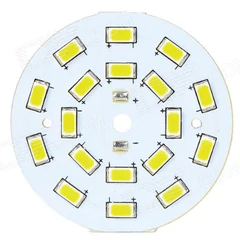
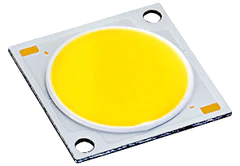
A COB light source can be improved in terms of luminous flux by integrating more LED chips, which also means more heat will be generated. When the heat dissipation is not effective enough, the heat will accumulate and raise the temperature of the PN junction. In this case, the luminous efficiency will be largely compromised, and it may lead to the failure of the chip, of other packaging materials, and even of the whole COB. To ensure the reliability, LED manufacturers usually try to improve the heat transfer efficiency by expanding the surface of the COB. However, this means higher cost of the accessories and bigger size of the light, making the optic design for lighting fixtures more difficult. It slows down the step of LEDs to replace conventional light sources. Hence, when designing a COB, it is always the key point to improve the luminous flux and the reliability while controlling the LES.
Based on this principle, YUJILEDSTM High Lumen Density High CRI COB Series was developed. After years of research and development, we proudly present to you this high CRI high reliability COB with the world’s highest lumen density.
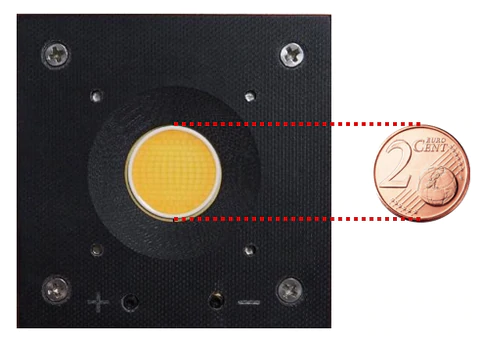
With an LES diameter of only 19 mm, this COB can achieve a luminous flux of 24000 lm at 5600 K, which is a luminous flux density of 88 lm/mm2. We did a research on 76 similar products by 15 well-known manufacturers on the market (including the famous Cr** and Ci** products). The result shows that COB has an overwhelming advantage of 40 lm/mm2 over the second place, and is 60 lm/mm2 higher than the average. That is to say, when emitting the same amount of luminous flux, YUJI COB has an LES only one fourth the size of other products. That creates large space for further optic design.
When the LES is minimized and the luminous flux is increased, how to solve the heat dissipation issue? First, flip chip structure and eutectic welding technology are adopted in our High Lumen Density High CRI COB products, where the chip is soldered directly onto the substrate. In a traditional face-up structure, the heat transfer route is: chip → adhesive → substrate. As shown in Figure 3, in the face-up structure (right), a layer of thermal conductive adhesive is applied in order to fixate the chip and transfer the heat, while the heat transfer efficiency of the adhesive is very low. While in a flip chip (left), the heat can be transferred directly to the substrate, increasing the efficiency. Second, this COB has AlN substrate with a heat transfer efficiency as high as 300 W/(m∙K), which is two times that of Al substrate, and six times that of Al2O3 substrate.

Additionally, the unique chip alignment design of YUJILEDSTM COB ensures that the heat is dissipated equally from the chip to the substrate, thus improving the reliability of the product. To evaluate the reliability, we ran a full power burn-in test on samples of three different color temperatures. After 6000 hours, the average decay of the examples was less than 1.5%, and the total lifespan (L70) was estimated to be over 70000 hours.
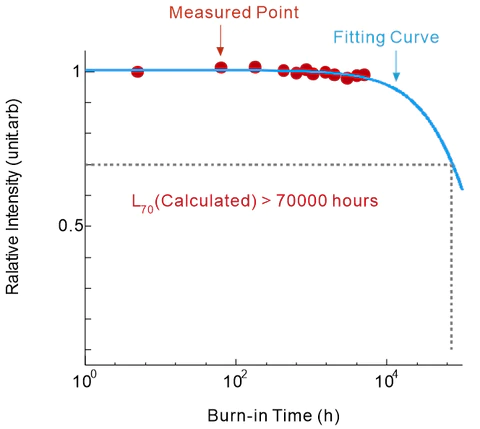
As we have stressed several times before, CRI is a significant parameter for evaluating light quality. For white LEDs using “blue light excites phosphor” solution, the color rendering performance is decided by three factors: the phosphor properties, the mixing ratio of the phosphors and the packaging process technology. These are especially important for high lumen products, because the excited phosphor also produce large amount of heat. That’s why the phosphor’s thermal reliability and COB’s heat management issue should be paid special attention to. To tackle this issue, YUJI developed the post-treatment process, successfully improving the thermal reliability of the phosphors. Then a unique packaging technology was adopted, by which the heat is dissipated efficiently through the chip and the encapsulant. According to the CRI test result (Figure 5) of the 5600 K sample, this product has a CRI (Ra) as high as 95 even at high color temperature. Besides, after 6000 hours of burn-in test (Figure 6), the product shows a color temperature shift smaller than ±50K, and the chromaticity shift is less than ±0.001. Statistics proves extremely high color rendering ability and high reliability of this COB.
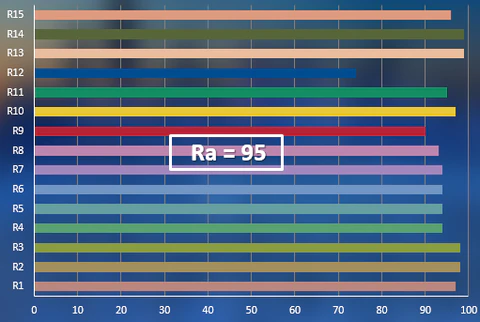
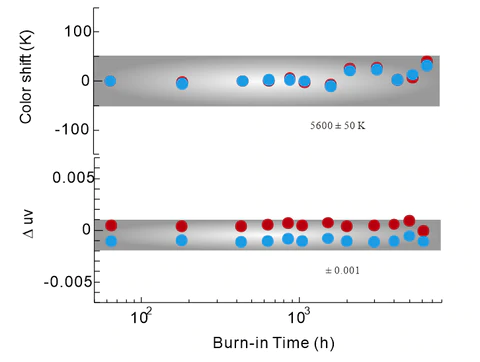
To meet the light requirements of different places, the YUJILEDSTM High Lumen Density High CRI COB Series also released another member, which has an LES diameter of 9mm and luminous flux of 6000-8000 lm. In the near future, YUJI plans to develop and offer more choices of this series, including a 6mm diameter product with 3000 lm flux and a 14mm diameter one with 15000 lm flux.
As an LED light source manufacturer, YUJI always focuses on light quality, and has been dedicated to the research and production of high CRI packaged LEDs since it was founded. In recent years, apart from CRI performance, YUJI has expanded its spectrum to take design into consideration, trying to provide more possibilities and convenience for downstream manufacturers. The latest High Lumen Density High CRI COB Series was born to actualize this idea.
